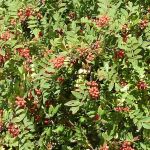| Common Name: |
Sansho |
| Other Names: |
Japanese Pepper |
| Botanical Name: |
Zanthoxylum piperitum |
| Genus: |
Zanthoxylum |
| Family: |
Rutaceae |
| Native Location: |
China, Korea, Japan and Taiwan |
| Cultivation: |
Fertile soil in sun or shade. Remove dead wood (which is prone to coral spot fungus) and cut back in late winter or early spring. |
| Propagation: |
By seed sown in autumn; by root cuttings in late winter. |
| Harvest: |
Leaves (Z. piperitum) are picked during the growing season and used fresh. Bark is stripped in spring and dried for use in decoctions, liquid extracts, and tinctures. Fruits are collected in summer and dried for use in decoctions and liquid extracts. |
| Height: |
2.5m (8ft) |
| Width: |
2.5m (8ft) |
| Variants: |
|
| Hardiness: |
Z6-10 |
| Parts Used: |
Leaves, bark, fruits, fruit pericarp or hull (hua jiao) |
| Properties: |
A spicy, warming, stimulant herb that acts mainly on the spleen and stomach. It lowers blood pressure, has diuretic, anti-bacterial, and anti-fungal effects, and is locally anesthetic. |
| Medicinal Uses: |
Internally for fever (bark), digestive complaints associated with cold (fruits), skin disorders, intestinal parasites. Externally for stings and bites (sap of young leaves). |
| Culinary Uses: |
An important herb in Japanese cuisine. Young leaves and shoots (kinome) are used as a garnish, and to flavor soups and salads. Fruit hulls are ground to flavor soups, noodles, and rice, and mixed with salt as a seasoning; also and ingredient of Chinese five spice powder, and Japanese spice mixture, known as shichimi. Seeds are simmered with soy sauce and rice wine to make tsukudani. Immature fruits are pickled. |
| Bibliography: |
The Encyclopedia or Herbs by Deni Bown Copyright © 1995, 2001 Dorling Kindersley Limited. pp. 409-410 |
